The thundering sounds of stampeding animals shatter the tranquil morning air. A herd of Torosaurus has just walked into an ambush on their way to the forest edge and are now running for their lives towards the safety of the open plains. The herd runs tightly together for safety except for one animal who seems to hesitate, stop, then breaks off from the group and heads back towards the forest edge. This separation is exactly what the predators wanted to happen and soon set their eyes on it and follows the lone animal towards the forest. Sensing that the predators are closing in, the lone Torosaurus makes one desperate attempt of escape and pushes its way through the thick forest undergrowth where it disappears amongst the tangle of vegetation.

In the forest, many hours have passed since the lone Torosaurus entered its depths, still there are no signs of movements that would indicate the whereabout of the animal. Eventually movements in the thick undergrowth and the sound of breaking branches gives the location of the animal as it slowly makes its way out of the thick tangle of plant where it took shelter. Now that danger has passed the animal slowly emerges into a small clearing unharmed, and right next to it a very small baby nervously follows.

The presence of the baby explains why this lone Torosaurus made the risky decision to break away from its heard and return back to the forest edge. She now faces a new challenge: how to get back to her herd safely with her youngster. In the distance she can hear the herd but to reach them she must cross a river that separates the forest and the open savannah.
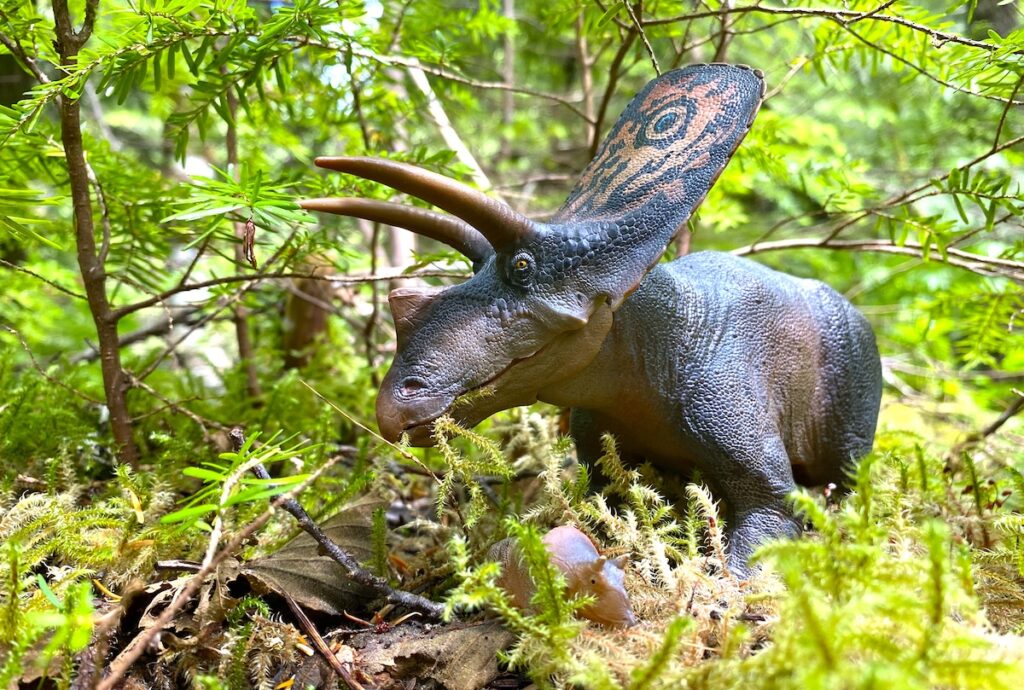
Torosaurus is a large ceratopsian from the late Cretaceous of North America. Surprisingly despite its large size and impressive head frill, it’s relatively obscure when compared to its close relative the iconic triceratops. In fact, seen side-by-side, Torosaurus may visually even look more impressive than triceratops due to its larger, longer skull and taller frill. So why hasn’t it reached the same level of fame as triceratops?Perhaps it is Triceratops close association with the most famous dinosaur of them all, Tyrannosaurus rex, that helped elevate it to iconic status; these two are forever intertwined throughout their long history that we can’t talk about or imagine one without the other.


It wasn’t until the movie Walking with Dinosaurs that I became aware of Torosaurus when it was featured in one of the segments. It seems like finally, Torosaurus was on its way into the mainstream and would soon be a household name. But that would not be the case and in the toy world despite its appearance in the movie very few models of this genus currently exist. On the top of my head, I know at least three of them the old Schleich, the official WWD figure, and the CollectA one, all now showing their age. And to complicate things even further, the very validity of Torosaurus has been questioned by some paleontologist: they suggested that Torosaurus is the same as the iconic Triceratops, only a more mature form. So, it joins the group of dinosaurs whose validity is in limbo as each side debated its future as a valid genus.
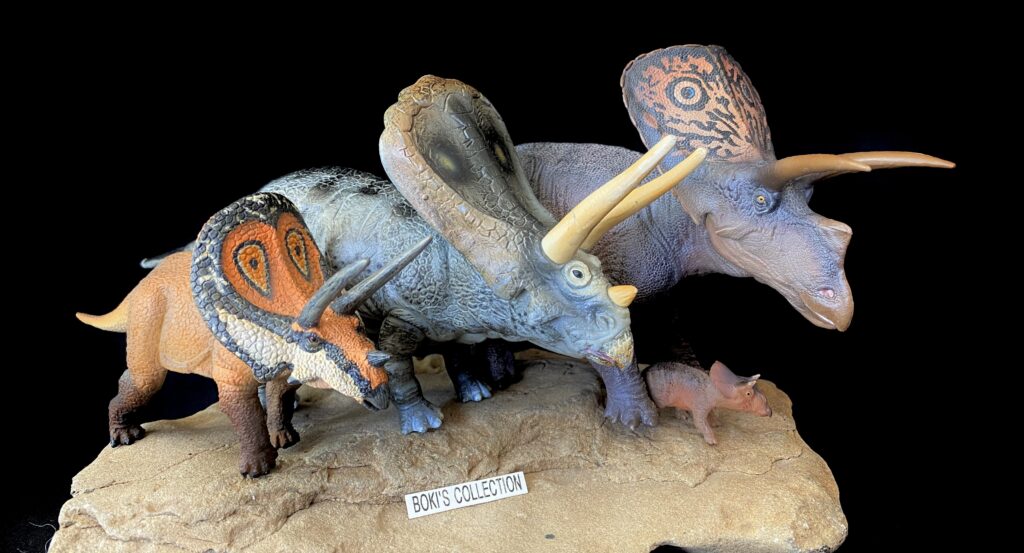
Like many ceratopsians, Triceratops and Torosaurus can be distinguished from one another by the difference in their skull and frill as the body are pretty much similar. The biggest difference between the two can be easily seen on how the frill. Torosaurus possessed one of the largest skulls and its frill is taller and more elongated with large openings ( the fenestrae). In comparison Triceratops frill is shorter, rounder and most importantly does not have an opening. Torosaurus also has a longer jaw that its famous cousin. While both have long brow horns, the nose horn on Torosaurus is shorter than that of Triceratops. There are more differences between these two, so many to try to cover, but it suffices to say that in the end, and after more comparison and study, the validity of Torosaurus prevailed and is recognized as a valid species and not a mature form of Triceratops. Of course, like many debates with hard-core sides, for some the debate still continues and is not settled. For me I am glad that Torosaurus is here to stay which brings us to our subject today.


Meet Aubrey and her baby Dabei the newest ceratopsian from the powerhouse PNSO, part of their 2022 Museum Line. With all other previous Torosaurus models showing age its exciting to finally get a new modern take on this classic ceratopsian. I’m glad that PNSO continued the additions of accessories to their Museum Line, in this case another baby. Although it would have been tempting or even logical to add a skull, especially given that it’s the most distinctive part of the animal and would have been a nice display next to Doyle the Triceratops, I’m happy that they opted for a baby instead.

The model is done at 1:35 scale and measures 8″ inches long and 5″ inches tall at the top of the frill, perfectly complementing both Doyle the Triceratops and the Tyrannosaurus family (Wilson and Andrea). As expected from PNSO, the model is top notch in sculpting from details to the color scheme. And as a Museum Line figure it comes with the large envelope full of amazing artwork and of course the deluxe elegant white box.
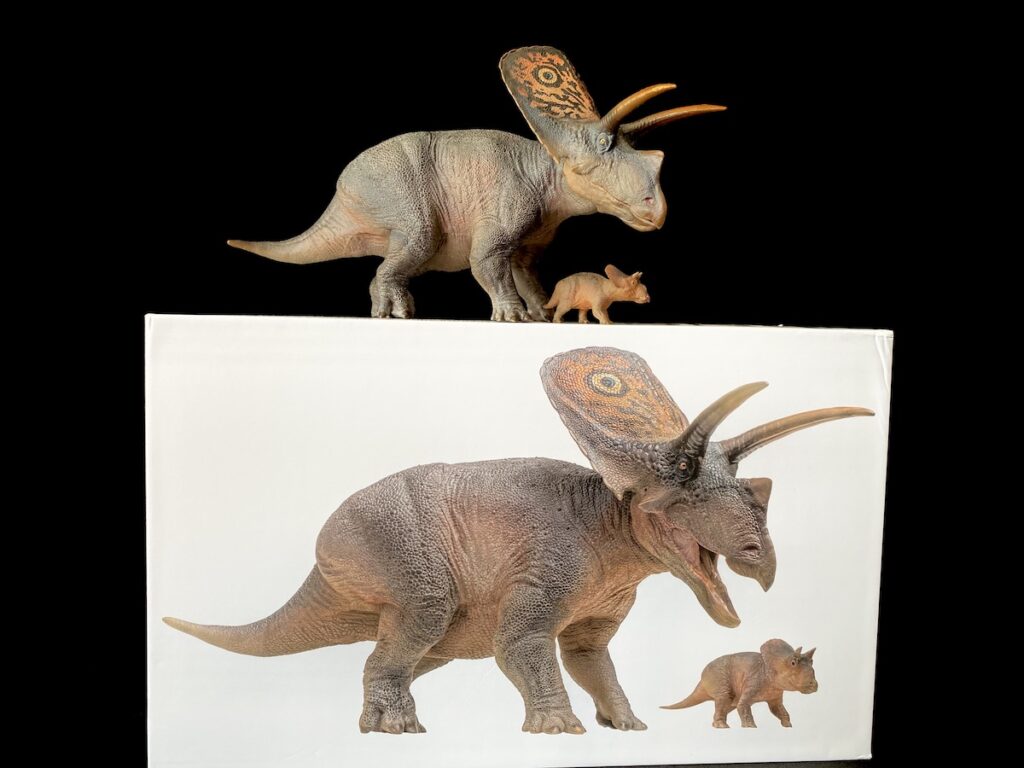
Starting with the head, the model is beautifully done and captured many of the subtle and obvious features that make it different from its famous cousin. The frill is unmistakable: it rises up in a spectacular fashion that looks more like that of a Pentaceratops than Triceratops. It is adorned by wide hornlets at its edges while small scales cover the surface of the enormous frill. At the middle of the frill, you see larger scales that run along the midline, while a cluster of even larger scales can be seen around the eyes and base of the horns that really add textures and visual interest.


These varying scale sizes continue down on the entire jaw and snout creating a mosaic of shapes that are pleasing. The small eyes are painted yellow with black pupils and meticulously painted with no bleeding. The two large brow horns orients forward in an impressive way and you can see growth rings around the base as it moves further up towards the tips. The nasal horn is smaller and wider than that of Triceratops which can easily be appreciated when you look at the two models’ side-by-side.

Perhaps one source of complaint about the model is the cheeks or in this case the lack of it. Now these whole cheeks or no cheeks debate has their solid base, for me personally I don’t have a preference as long as done well which is the case in this model. Some promo photos angle made the lack of cheeks look so extreme, but that is not really the case in person (of course it also varies by individual personal opinion or taste). So, if you are pro-cheeks then this may not be a model for you, but if you don’t have preference this model definitely is worth adding to your ceratopsian herd.
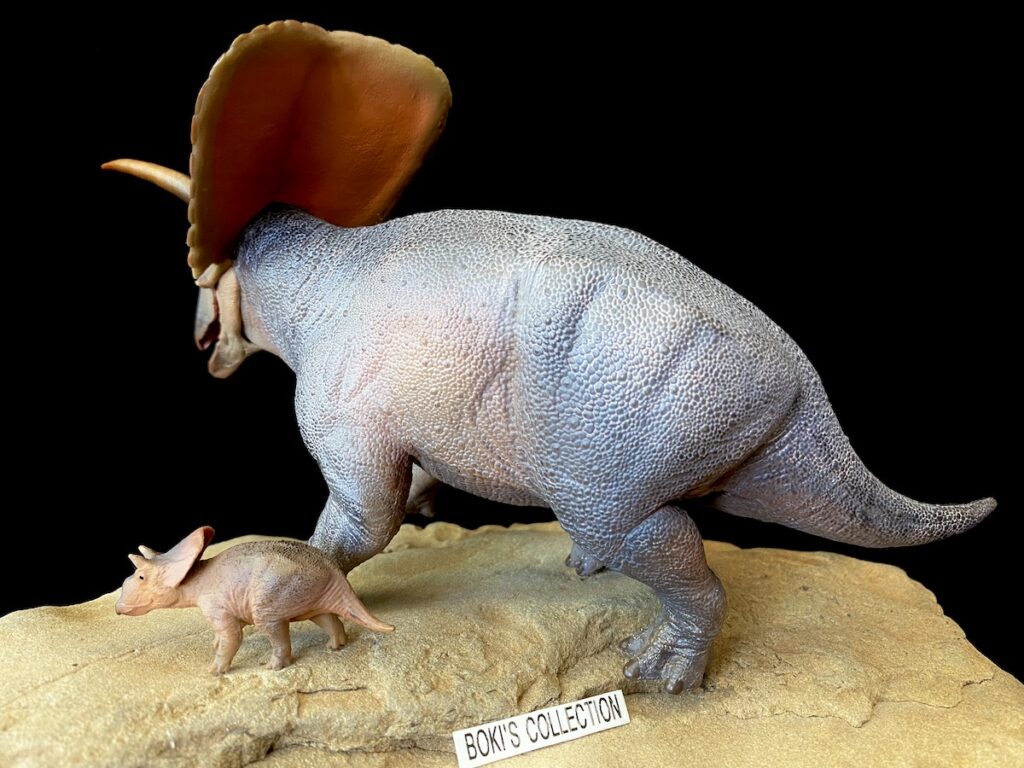
The snout of Torosaurus is longer and narrower than Triceratops and that is easily appreciated in the model especially when you view the two figures together. I love how PNSO really gave these deferences, as subtle as some of them are, emphasis to make the two models look different. The beak is big and nicely sculpted and inside the mouth you can see all the exquisite details that’s become a PNSO standard. The jaw is also articulated nicely and keeps its position very well, this articulation provides options of how you want to display it.
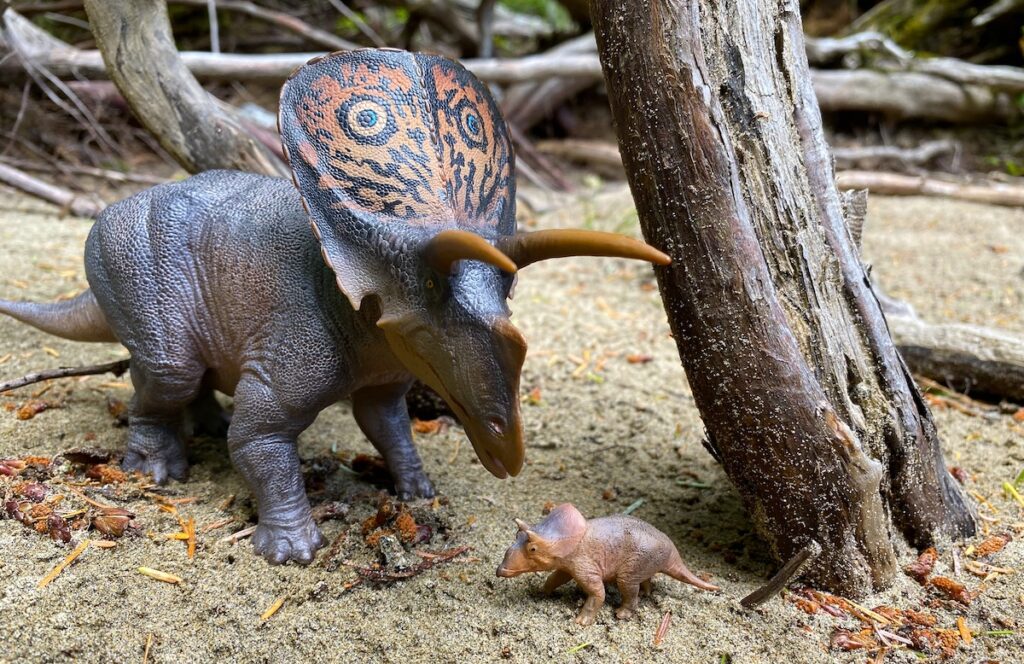
As for the rest of the body, it’s your typical well-sculpted and very detailed model from PNSO, it has all the details, big and small, that have come to define this brand’s artistic prowess and exceptional attention to details. The main body color is a dark, almost grayish-brown with lots of subtle lighter colors mixed in that creates wonderful depth and complexity. This color departs from the majority of PNSO’s brown-colored ceratopsians which is a welcome break.
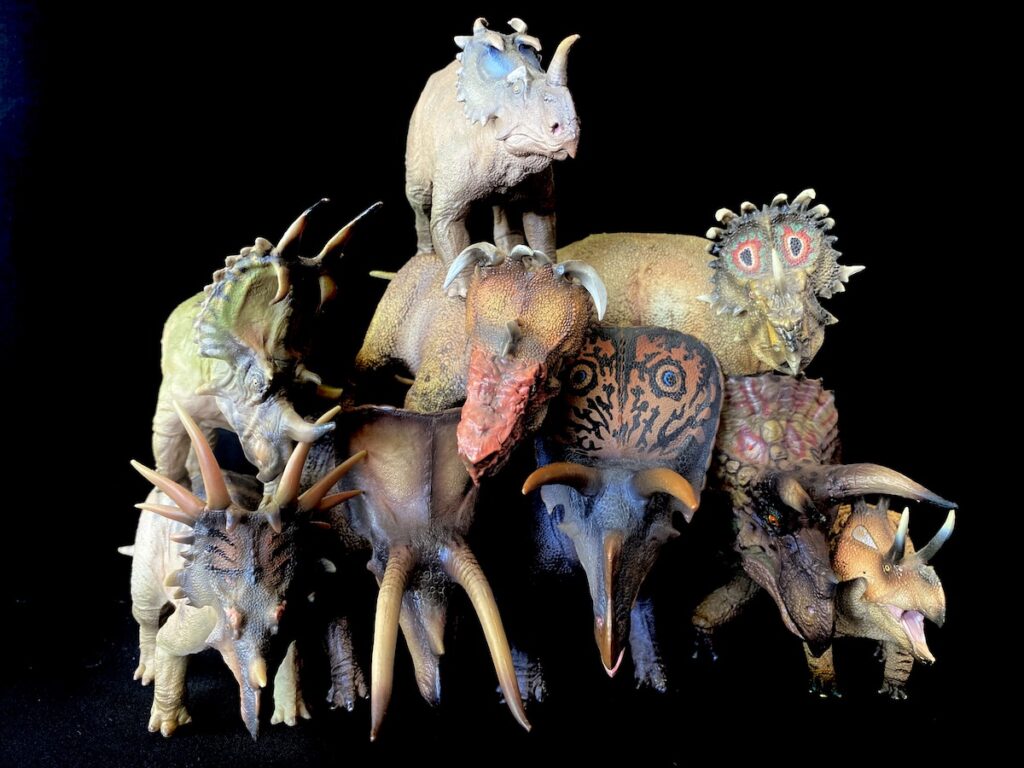
The colors really are rich and on the dorsal part there is what appears to be a bluish hue that comes out in certain light conditions. A reddish tone forms a highlight band that starts from the snout and runs all the way down the middle part of the body and tail while an orange-pink combo highlights some areas such as the armpits and skin folds. The beak is brown while the toenails are gray. The nasal horn is given a brown color while the brow horns a much lighter yellowish-orange that gradually fades as it moves up towards the tips.
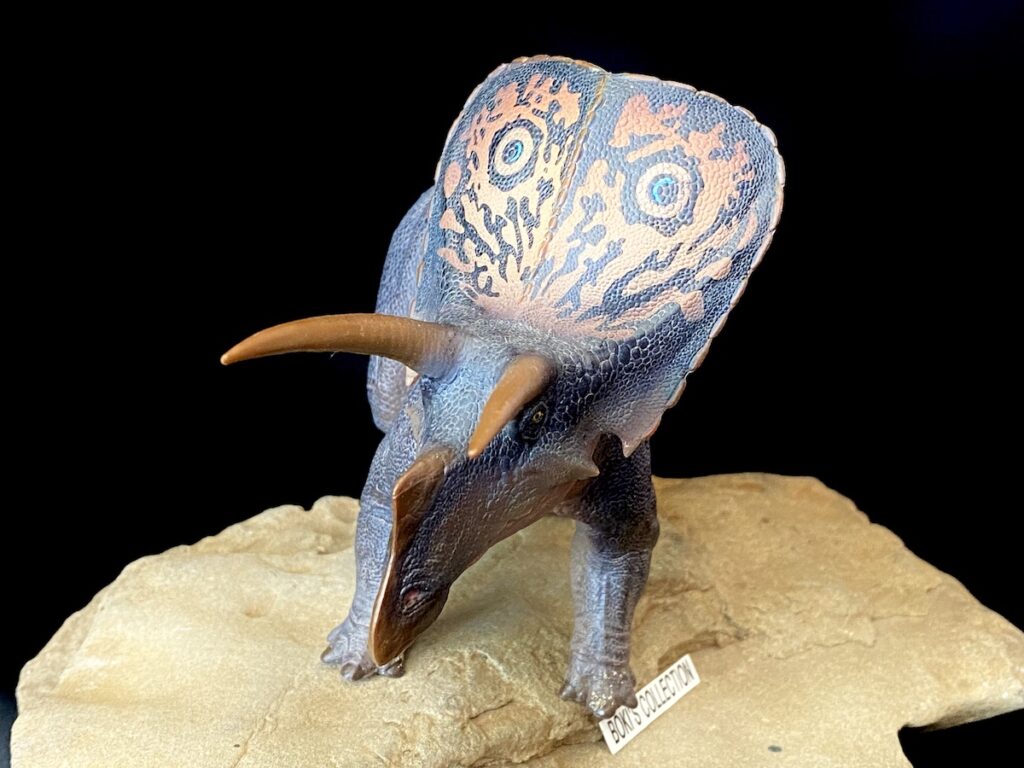
Now for the really eye-catching part, the frill colors! Ceratopsian frills are often a missed opportunity on mass produced figures as companies often give them simplified colors and designs. This model sports one of the most striking designs seen on a model, even eclipsing all other PNSO ceratopsians to date. The frill itself is the same dark color seen on the body but it is broken by golden-orange color in the form of spots and stripes that break up and create a striking patter reminiscing of tiger stripes. Topping it all off, at the center of either side of the frill there are eyespots! These are encircled by black colored rings, yellow-orange, then at the center of it is a spot with one half black and the other bright blue! The overall design are simple yet demonstrates how even such simple colors and patterns could result in stunning results as seen on this model.
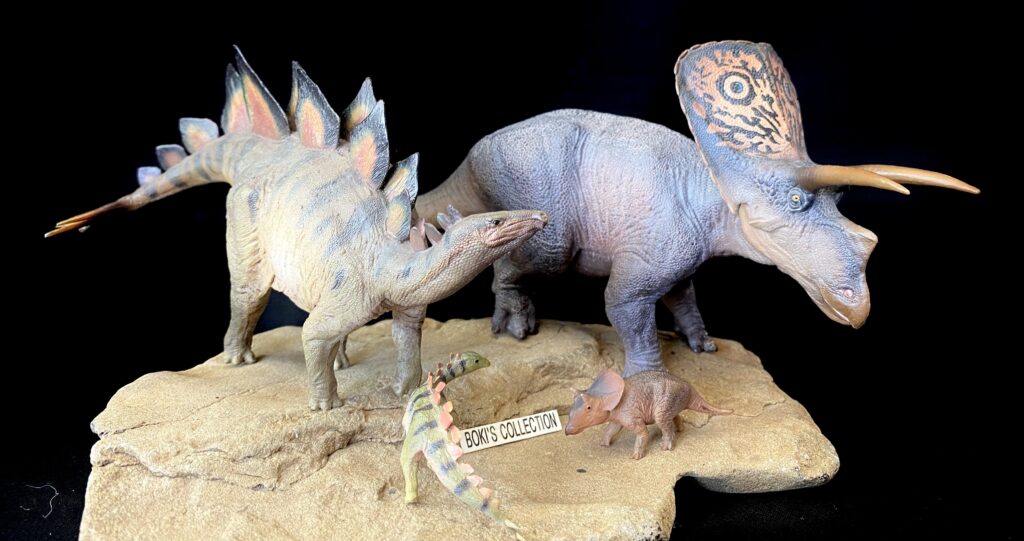
As for little baby Dabei, it’s very small and cute without resorting to exaggerated or caricature that often plague models of baby dinosaurs. At just 2″ inches long, this little one is packed with very small and delicate details. The scales are visible and very fine which is appropriate for such young animal, you get the feeling that these scales are not yet as hardened as those of an older animal. There are plenty of minuscule skin fold as well that really adds some texture. Its head is also full of details; it has two little brow horns that are rounded and its nasal horn is just a raised bump.


The beak and snout show well defined details that exude some character. The eyes looks bigger in proportion but is appropriate for an animal this young are painted black. The frill is smooth and still has a rounded look to it as expected on a very young animal and its brow and nasal (just a small bump) horns are already showing but are blunted. The colors, while nothing spectacular, are appropriate for a young animal. Light brown dominates and there are some areas where you see some yellow mixed in as well as a pinkish-tone that gives it that young-skin appearance. At close up you will see a seam line on its back visible, but in my opinion this is not distracting at all unless you are viewing it at a very close range. You can see this in the various photos of close up vs a little distance.
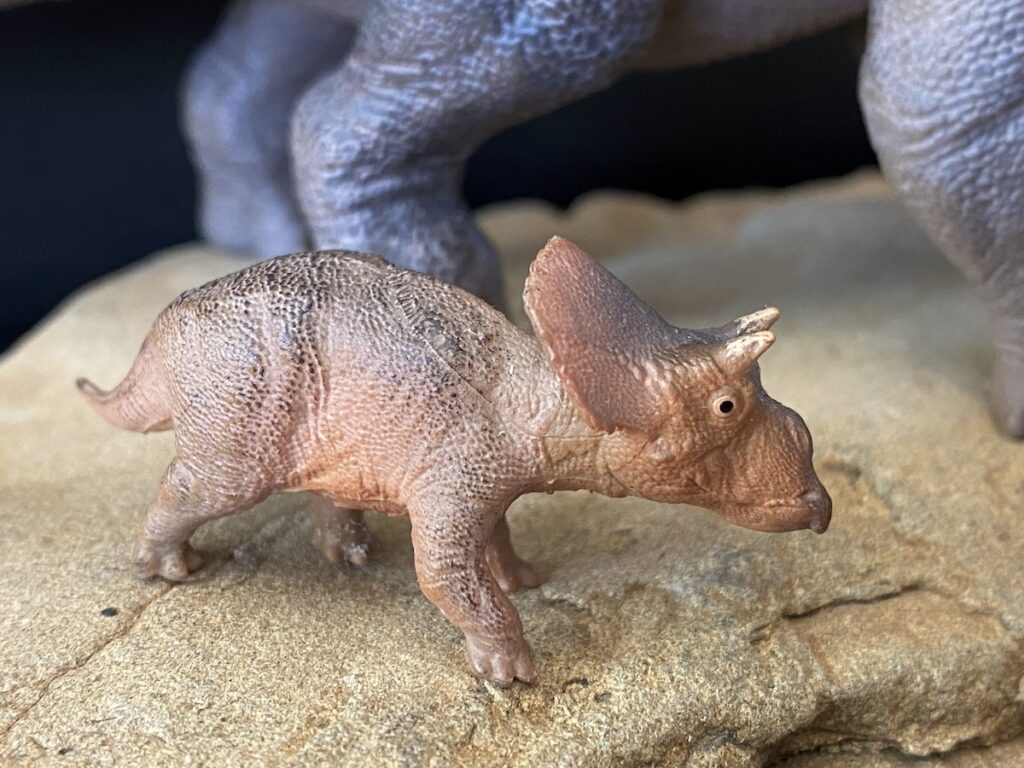
The mother and baby would soon find their way towards the herd and the safety it provides. The mother decided to take the shorter route and crossed the river, putting herself behind the youngster to keep the baby from getting swept by the river current. Once they have safely crossed the river the mother allowed the little one some time to explore this new and wet surroundings before that are all new to it. In time they move on to join the herd.
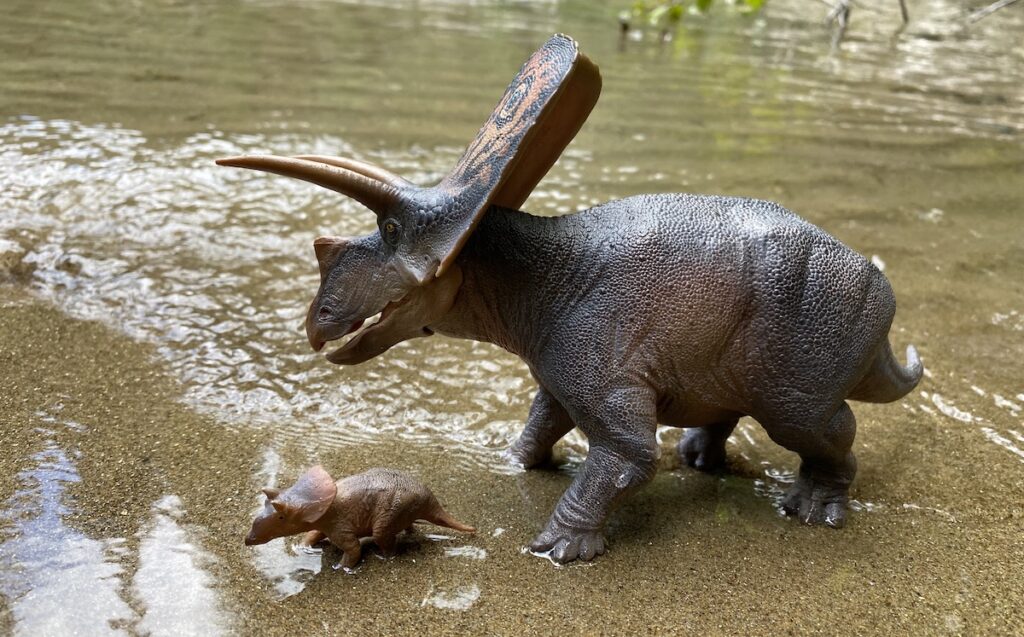
In closing, I find this pair of Torosaurus mother and baby to be a wonderful addition to my ceratopsian and PNSO collection. It’s nice to finally get an updated take on this old classic that is often overlooked in favor of more exotic looking ceratopsians. The addition of the baby adds a little bit of story to an otherwise straightforward model, something the accompanying artworks, as beautiful as they are, does not provide.
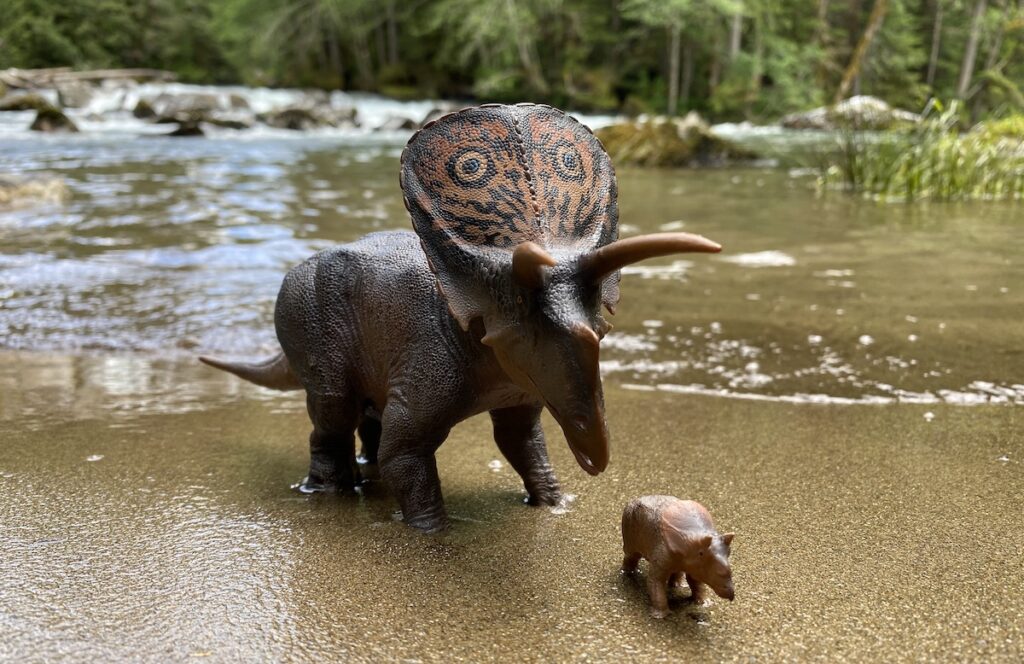
Beautifully sculpted and executed in all levels, it truly is a work of art that surely catches one’s attention. I know PNSO already have an impressive ceratopsian herd, but surely, I’m hoping that they would get around and produce a Chasmosaurus in the near future.
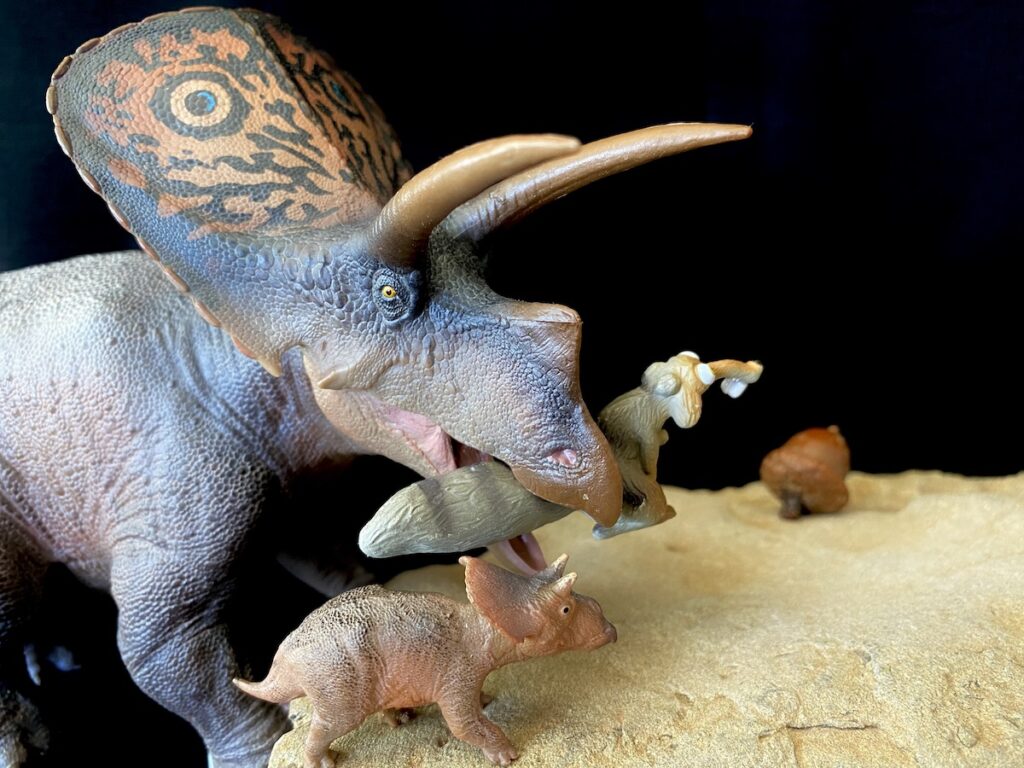
Hope you enjoyed the review, thanks for reading. Until the next review, stay safe and healthy. Cheers!
Disclaimer: links to Ebay and Amazon on the DinoToyBlog are affiliate links, so we make a small commission if you use them. Thanks for supporting us!





Torosaurus is my favourite Dinosaur and by the way the adult Triceratops-theory is already debunked. The PNSO Model is the best model of this species I’ve ever seen and I like the no cheeks version, because it’s more assumed, that they didn’t have any of them. The Model is yet my favourite PNSO dinosaur and so gorgeous!
Es un torosaurus genial, en cuanto a pintura, modelado y detalles. Eres una figura muy deseable. Gracias por la revision como siempre Bokisaurus
Great review of a fantastic sculpt. This Torosaurus is a wonderful upgrade, sculpt-wise, and makes a nice sidekick to the original “prancing” Triceratops Doyle. (The godawful Doyle 2.0 I will not comment on other than to say its the most disappointing of the PNSO figures for me to date, in terms of its wasted potential).
Back to the Torosaurus – the baby is a nice sidekick and the WWD-vibe is most welcomed. 5 Stars for this PNSO offering!
I always thought that one of the reasons why the ‘Toroceratops’ theory was discarded was because of how Torosaurus remains are so rare compared to how common those of Triceratops are.
Torosaurus has only 8 remains, and the first two are still the most complete. Triceratops has hundreds.
Excellent work as always. As much as I’d like a high quality Torosaurus toy, this one is too expensive for me to justify.